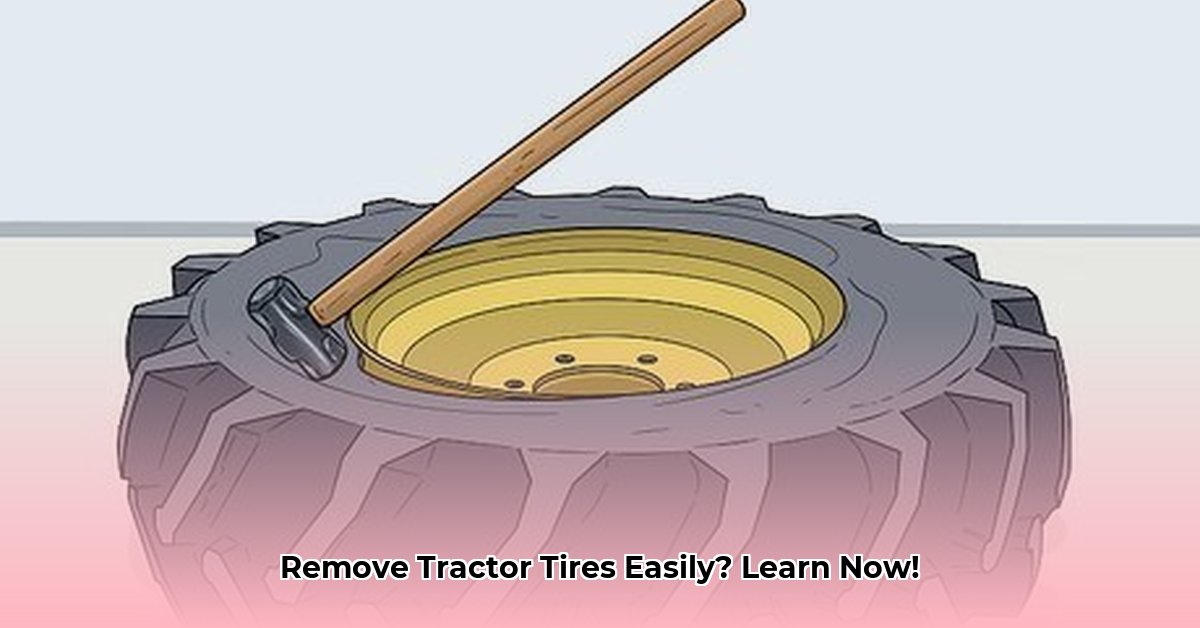
Removing a tractor tire from its rim can seem daunting, but with the right approach and safety precautions, it's a manageable task. This guide provides a step-by-step process for safely removing tractor tires, regardless of your experience level. Proper tire maintenance is crucial for both efficiency and environmental responsibility on your farm. For additional tire maintenance tips, check out this helpful resource on tractor tire sealers.
Sizing Up the Situation: Preparing for Tire Removal
Before you start, assess the situation. The size of the tire and the tools available significantly impact the process. Larger tires require more effort and specialized tools. Ensure you have the necessary equipment before beginning. Having the right tools will not only make the job easier but significantly reduce the risk of injury.
Safety First: Your Pre-Removal Checklist
Safety is paramount. Ignoring safety protocols can lead to serious injury. Always prioritize the following:
- Completely Deflate the Tire: This is crucial. A pressurized tire is under immense pressure and can spring back violently during removal, causing injury.
- Protective Gear: Wear safety glasses to protect your eyes from debris, sturdy work gloves to prevent cuts and scrapes, and strong boots with good ankle support.
- Stable Workspace: Choose a level, stable surface to prevent the tire or rim from rolling during the removal process.
- Ventilation: Work in a well-ventilated area to avoid inhaling potential fumes released during tire removal.
- Partner Up: An extra pair of hands is always helpful, especially when dealing with larger or stubborn tires. This collaborative approach enhances both safety and efficiency.
Removing the Tire: A Step-by-Step Guide
With safety precautions in place, let's begin the removal process.
Step 1: Breaking the Bead (The Most Challenging Part)
This step often presents the greatest difficulty. Use tire irons (or a bead breaker for easier handling, especially on larger tires) to carefully pry the tire's bead (the edge of the tire that sits against the rim) away from the rim. Work your way around the tire slowly and methodically, applying soapy water (a fantastic lubricant) liberally to reduce friction and make the process smoother.
Step 2: Removing the Tire from the Rim
After breaking the bead, carefully use the tire irons to leverage the tire off the rim. Continue applying soapy water to minimize friction. This process requires patience and a steady hand. Work slowly and methodically around the tire.
Step 3: Post-Removal Inspection
Once the tire is removed, inspect both the tire and the rim for any damage (cracks, bends, etc.). Damaged components pose significant safety risks and should be addressed before reuse.
Your Tool Kit: Essential Equipment
The specific tools needed vary depending on the tire size, but the following are essential:
| Tool | Purpose | Necessity |
|---|---|---|
| Tire Irons | Prying the bead and tire from the rim | Essential |
| Bead Breaker | Significantly simplifies bead breaking, crucial for larger tires | Highly Recommended |
| Soapy Water | Acts as lubricant, reducing friction and risk of damage | Essential |
| Air Compressor | For deflating (and later inflating) the tire | Essential |
| Wheel Chocks | Secures the wheel, preventing movement | Recommended |
Sustainably Managing Used Tractor Tires
Responsible disposal of used tires is crucial for environmental sustainability. Landfilling whole tires is environmentally damaging.
Recycling and Repurposing: Eco-Friendly Alternatives
Recycling used tires minimizes environmental impact. Many facilities process them, transforming them into usable materials. However, finding facilities that handle large agricultural tires can be challenging, and transportation costs can be significant. Repurposing old tires (e.g., creating makeshift planters, weight for tarps) is an alternative method to reduce waste and lessen dependence on new tires.
Cost Considerations
Recycling and repurposing aren't always cost-free. Transportation, processing, and labor can add up. Compare these costs to the environmental consequences of improper disposal.
Local Regulations and Compliance
Local regulations concerning tire disposal vary. Before disposal, check your local ordinances to avoid penalties and ensure compliance. Some areas offer financial incentives for environmentally responsible tire management.
When to Call a Professional: Recognizing Your Limits
If you're uncomfortable or dealing with exceptionally large tires, don't hesitate to contact a professional tire shop. While DIY approaches can save money, safety always comes first.
Troubleshooting Common Issues
- Stubborn Bead: Additional soapy water, patience, and possibly a bead breaker will usually resolve this.
- Tire Damage: Do not use a damaged tire or rim. Damaged components present significant safety risks.
This guide provides a comprehensive and safe method for removing a tractor tire. Remember to prioritize safety, work methodically, and seek professional assistance when needed.